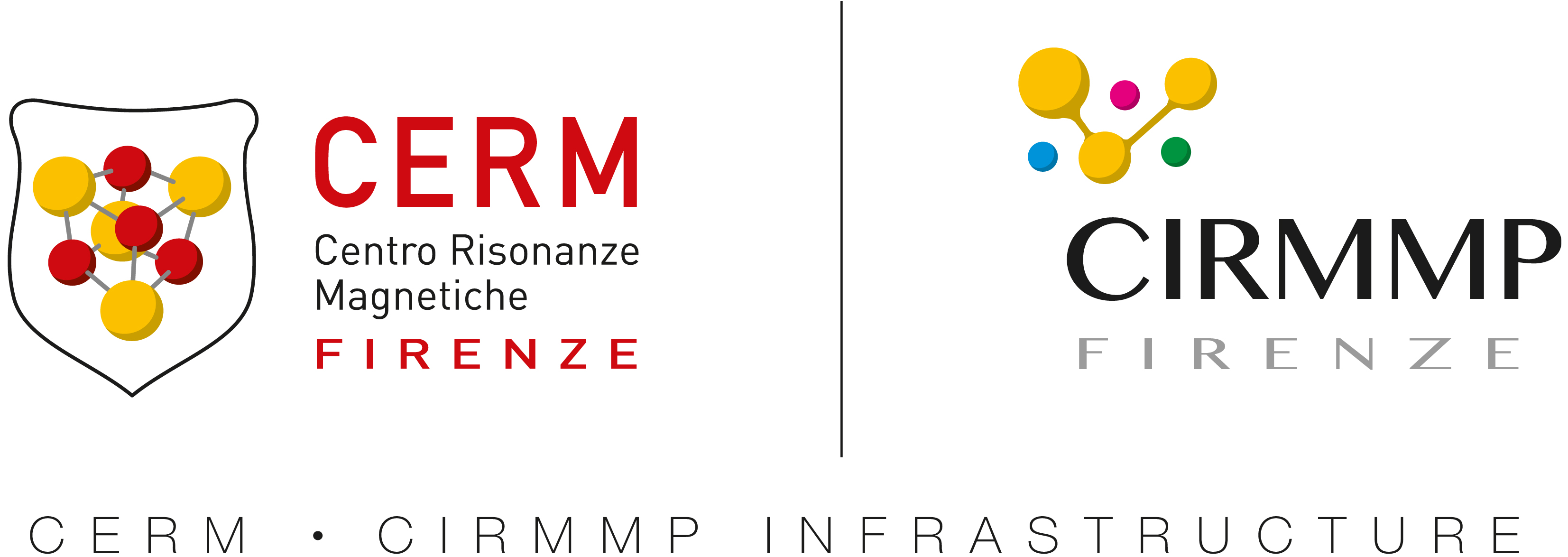The infrastructure is specialized in structural biology, molecular biology, protein/complex structure determination, functional characterization, drug discovery, structure-based vaccine design, bioinformatics, NMR methodology, relaxometry and metabolomics. The scientific outcome of the infrastructure is largely in the field of Structural Biology and of Molecular Systems Biology.
CERM/CIRMMP is the Italian node of Instruct-ERIC, a European distributed research infrastructure Landmark on the ESFRI Roadmap, making high-end technologies and methods in structural biology available to users.
CERM/CIRMMP is also an e-infrastructure, managing a GRID based platform for providing access to user friendly platforms and CPU resources for a broad range of computational programs and tools relevant for structural biology.
Platforms available for access through Instruct-ITALIA
- Solution NMR
- Solid State NMR
- EPR
- Relaxometry
- Cryo-TEM Glacios
- *NEW* Covid-19 Computational Services
- Computer-based modeling of 3D protein structures
- Analysis of NMR-based screening data
- Computer-based modeling of protein-ligand adducts, both ab initio and driven by experimental data
Other platforms at CERM/CIRMMP - access available only via Instruct-ERIC
Instrumentation
Each of the eleven high-resolution NMR spectrometers, ranging from 400 MHz to 950 MHz, is equipped with several probes to meet all conceivable experimental conditions. On the low field end CERM offers unique instruments for the measurement of nuclear relaxation at various magnetic fields: a Fast Field Cycling Relaxometer, operating in the 0.01- 40 MHz range.
The Cryo-TEM instrument is a Cryo TEM Glacios equipped with X-FEG high-brightness gun 200 keV, Autoloader 12 grids, C-Twin pole piece, Volta Phase Plate, FEI Falcon 3 Electron Counting DED, FEI Ceta camera and EPU and Tomo4Bruker AVIII400 UltraShield Plus.
Techniques
Protein isotope labelling
The isotope labelling platform at CERM/CIRMMP is devoted to the large scale production of proteins uniformly enriched in stable isotopes (15N, 13C and 2H) for biomolecular NMR spectroscopy studies. The platform is offering protein expression in bacterial cultures grown on chemically defined minimal media, as well as advanced protein purification approaches with the unique possibility of running them in anaerobicity. Users have access to the facility for large scale expression of labelled proteins in E. Coli, under the supervision of a qualified platform engineer. A protein expression protocol that uses an E. coli strain and a rich medium, i.e. LB or 2YT or Terrific Broth etc., is required.
Access to this platform is provided via Instruct-ERIC. Proposal submission is available here.
Protein production in mammalians cells for in-cell NMR /in-cell NMR
The mammalian expression for in-cell NMR platform at CERM/CIRMMP is devoted to the to the production of mammalian cell samples overexpressing the protein of interest for its characterization by in-cell NMR. It relies on transient transfection in HEK293T adherent cells. The gene of interest is cloned in a vector optimized for high constitutive cytoplasmic expression. Small scale transfections are performed to determine the expression level and to assess the feasibility of in-cell NMR. Cell samples for NMR are produced in T75 flasks. Different protein labelling strategies are possible, e.g. U-15N labelling; amino acid type-selective 13C,15N labelling. Co-expression of two or more proteins is possible. In-cell NMR experiments are required to be performed at the CERM/CIRMMP solution NMR platform.
Access to this platform is provided via Instruct-ERIC. Proposal submission is available here.
Given the highly experimental nature of the technique, variation to the access scheme outlined above are possible, which will be discussed on a case-by case basis. Users are invited to contact the facility prior to submit a proposal.
Complete details on platform are available here.
Solution NMR
CERM/CIRMMP provides state of the art instrumentation and expertise to perform the most comprehensive array of experiments needed for the structure and dynamic characterisation of biological macromolecules and their complexes. All the standard pulse sequences for spectroscopic, structural and dynamical characterisation are available for attaining fundamental atomic level information.
CERM/CIRMMP have developed 13C direct detection protocols for “protonless” NMR experiments and for in-cell NMR spectroscopy, and tailored pulse sequences for structural determination of paramagnetic systems.
The infrastructure is equipped with high field spectrometers equipped with cryoprobes (950 MHz TCI cryo, 900 MHz TCI cryo, 700 MHz TCI cryo, 700 MHz TXO cryo, 500 MHz TCI cryo), heteronuclear detection probes at 600 MHz for low frequency nuclei to meet the most disparate experimental needs, liquid handler system and autosamplers for metabonomics and ligand screening at 400, 600 and 700 MHz. Special accessories such as high power probes (short hard pulse) at 400 and 600 MHz for paramagnetic NMR. All NMR instruments are state-of-the-art digital spectrometers of the Bruker Avance NEO/III series.
Solid State NMR
Solid-state NMR available at CERM/CIRMMP is typically applied for the determination of fibril structures and to obtain atomic-level structural information of biomolecules when they are bound to or trapped in solid matrices that lack long-range three-dimensional order. Detailed structural studies can be accomplished by exploiting the effects induced by the presence of paramagnetic metal ions. CERM/CIRMMP has a long tradition in the determination of paramagnetic effects in the solid state to access structural information.
Three solid state spectrometers are available:
850WB Avance III-HD: PH MAS 850WB BL3.2 N/C/H DVT 3.2 mm + PH MAS 850W6 BL1.3 X/Y/F-H DVT 1.3 mm + PH MAS DVT 850W6 BL0.7 N/C/H 0.7 mm
800SB Avance III-HD: PH MASDVT 800S5 BL1.3 Y/X/H TRIGAMMA 2 + PH MAS DVT 800S5 EF CNH 3.2 + PH MAS DVT 800S5 TL2 HCN
700WB Avance AV: CPMAS DVT 1H/BB/BB 4 mm + CPMAS DVT 1H/BB/BB 3.2 mm
EPR
The platform includes two EPR instruments (Continuous-wave X-Band and Continuous-wave/Pulse Q-Band), the necessary sample preparation wet lab (including glove-box) and the necessary processing computer. EPR measurements can be performed on biological samples containing paramagnetic metal ions (i.e. Fe, Cu, Mn etc.) or on samples opportunely labelled with paramagnetic tags (i.e. spin labels). The pulse Q-band EPR instrumentation permit to measure DEER, HYSCORE and ESEEM experiments.
Relaxometry
Relaxometry is a technique that has been developed to obtain structural and dynamical information on nuclear spin systems. In the presence of a paramagnetic metal ion in the compound under investigation, relaxometry may provide information on the coordination of the nuclear spin with respect to the paramagnetic metal and, indirectly, information on the electron spin system.
The instrument is operating between 0.01 and 42.6 MHz and it is designed to measure the field dependence of the NMR longitudinal spin-lattice relaxation time.
Cryo-TEM Glacios
CryoEM is particularly useful for molecules and complexed that are large, variable or unstable to be studied by X-ray crystallography or NMR. It can be used to understand the structure, assemblies and function of various biological macromolecules.
The designed-in connectivity ensures a robust and contamination-free pathway throughout the entire workflow, from sample preparation with the Vitrobot system and optimization to image acquisition and data processing.
The Glacios Cryo-TEM can be used in a single particle analysis (SPA) workflow for pre-optimization of sample quality, as well as for high-resolution SPA data acquisition and for tomography. Furthermore, the Glacios Cryo-TEM can also be configured with a Direct Electron Detector and/or Volta Phase Plate to be a complete standalone SPA data acquisition solution.
The instrument allows enable multiscale observations of 3D biological structures in their near-native states, informing faster, more efficient development of therapeutics.
Covid-19 Computational Services:
Computer-based modeling of 3D protein structures
Structural modelling of required Covid-19 protein variants.
Analysis of NMR-based screening data
Application of automated pipelines for the analysis of high-throughput screening of compound libraries against Covid-19 targets performed by NMR spectroscopy.
Computer-based modeling of protein-ligand adducts, both ab initio and driven by experimental data
Virtual screening of compound libraries against Covid-19 protein structures, to be performed either without any experimental information or including information such as mapping of the interaction surface.

